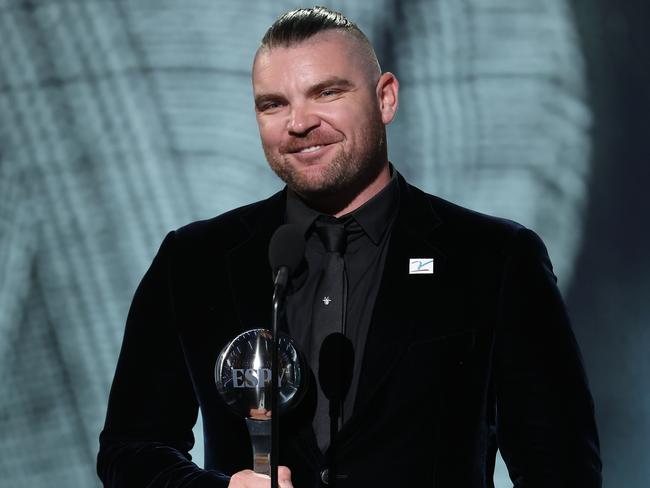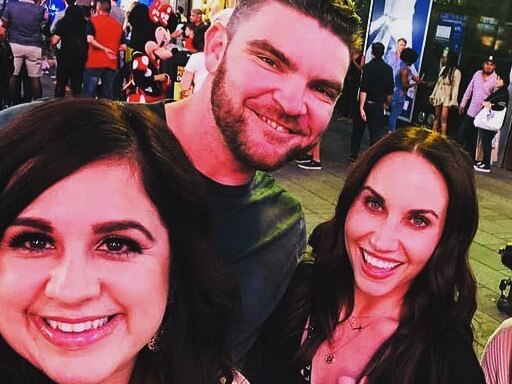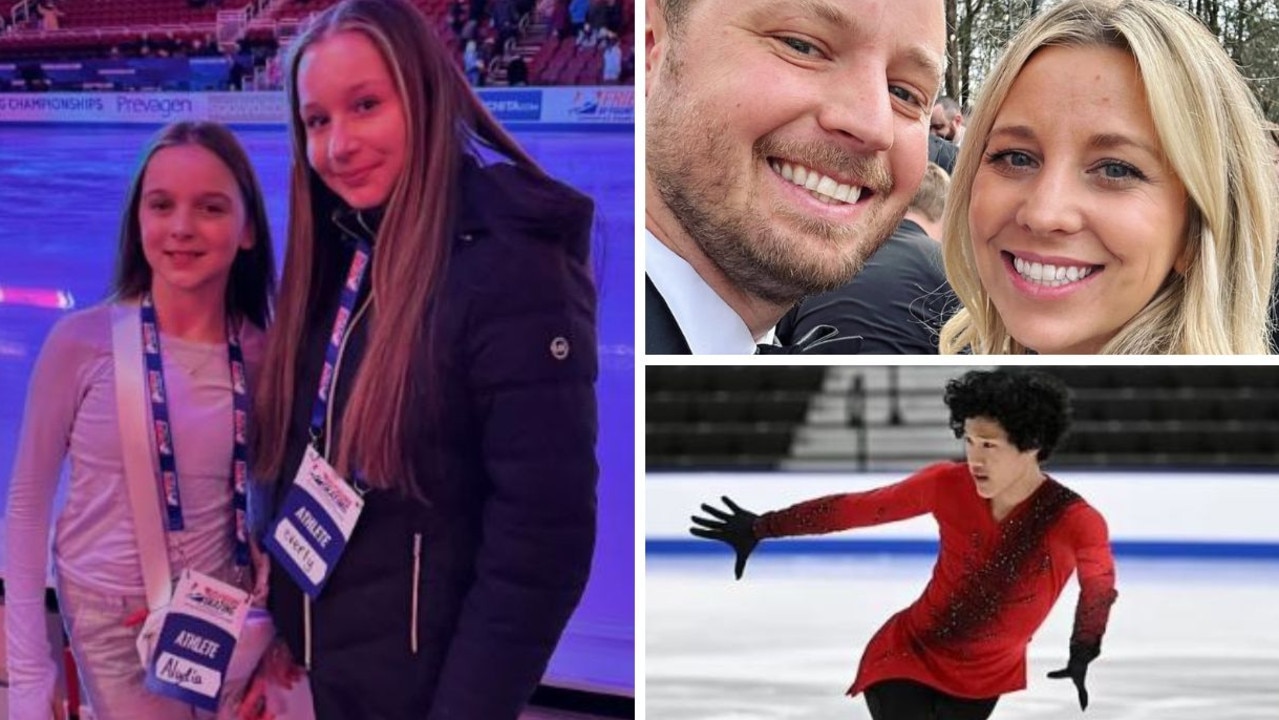Australian baseball star Liam Hendriks reveals inspirational comeback after cancer
Liam Hendriks went from a Major League Baseball journeyman to an All-Star and one of Australia’s richest athletes. Little did he know his body was riddled with cancer.

World
Don't miss out on the headlines from World. Followed categories will be added to My News.
There’s white line fever, and then there’s Liam Hendriks on the mound.
In between hurling pitches at 145 km/h, the Australian baseball player swears, screams and stamps his feet, fired up by what he says is “any little slight” he spots from his opponents.
“Like this guy, I don’t know, his pants look too baggy for what he should be wearing,” says Hendriks, one of our highest-paid but least-known sports stars.
“Or I saw this guy in the outfield today and he didn’t say hello when I said hello to him. Like, f*** this guy, pretty much, that’s the mentality.”

“You just hate that guy for no matter what … I’m going to destroy that guy, I’m going to make sure his family is embarrassed by him.”
Hendriks, you might already be thinking, is not a particularly nice person.
But playing angry – typically at himself rather than anyone else – helped transform Hendriks from a US Major League Baseball journeyman into a three-time All-Star. And, to the amusement of teammates and rivals alike, his fiery pitching persona is completely at odds with the wisecracking, Lego-building, coffee-swigging man they know and love off the field.
All of this is a long way of explaining what Hendriks found to be the hardest part of returning to the mound last year after 214 days on the injury list for the Chicago White Sox.
He had been out with cancer, you see. Stage four non-Hodgkin’s lymphoma, the fourth of four stages, meaning the cancer had spread throughout his body. It would have been understandable if baseball was the furthest thing from his mind, but just days after starting a brutal course of treatment, Hendriks had circled May on his calendar to start playing again.

And then there he was, May 5, bottom of the seventh innings for Chicago’s Minor League team, when the opposing Gwinnett Stripers players rose to give him a standing ovation.
How could he hate them – and fire himself up – when they were celebrating his return?
“It’s really hard to dislike guys when they’ve got that kind of attitude,” Hendriks laughs.
“You start humanising the enemy.”
The applause kept coming. He returned to the majors in Chicago on May 29 in front of 23,599 roaring fans, and also presented a $US100,000 cheque to the Lymphoma Research Foundation, having raised the money with the White Sox during his cancer battle.
Six weeks later at the ESPY Awards, the night of nights in US sports, Hendriks received another standing ovation when he won the prized Jimmy V Award for Perseverance.

He was anxious then too, but not because he had to speak in front of everyone from NBA all-time scoring leader LeBron James to three-time Super Bowl MVP Patrick Mahomes.
“I was nervous less about what I was going to say and more about the fact that I had a teleprompter,” Hendriks recalls.
“I don’t have the best eyes and I tend to ramble, so a teleprompter is like my worst enemy.”
“I remember looking at it, I’m reading it off, and I thought that I needed to engage the crowd because that’s who I am … So I’m looking around and then I get back and I have no idea where I’m at and no clue what’s going on.”
“But it was really cool. You’re in a room full of some of the best athletes alive and some of the best athletes in their chosen professions ever, which when you really think about it is ridiculously insane.”
“I remember I started talking about mindset, about the way I approach things … and they’re all just sitting there and nodding along. That just ratified in my own head that I’m doing something that I know is going to have an impact on other people.”
‘WHY NOT ME?’ THE MINDSET THAT HELPED SAVE HIS LIFE
Changing his mindset changed the course of Hendriks’s career – and his life.
In 2018, when his baseball future was admittedly “sitting on a knife’s edge”, his wife Kristi came across the Instagram profile of Rubi Sandoval, a tarot card reader and spiritual guide.

Kristi put her husband in touch with Sandoval, who quickly identified Hendriks’s negative tendency to ask “why me?” about problems that were out of his control.
While she knew nothing about baseball, Sandoval helped Hendriks ignore the expectations of others, stop dwelling on mistakes and start focusing solely on perfecting his craft. He calmed down off the field and channelled his emotions into performing on the mound.
Instead of asking “why me?”, Hendriks started asking “why not me?”. And so when he learned he had cancer at the end of 2022, he decided to confront it the same way.
“Rubi’s impact on me was profound,” he says.
“Little did any of us know that it went from being a purely performance-based thing on the field, to then me kind of overdoing it and taking it into every single facet of my life, which really kept me on the straight and narrow when I was diagnosed.”

“Who knows how I would have reacted if this had happened a few years earlier.”
The stage four diagnosis was nevertheless a rude shock for Hendriks and his wife.
He had been an MLB All-Star for a third time in 2022, although he was plagued by pain in his knee, back and elbow in the latter stages of the season. His lymph nodes were also inflamed, prompting a blood test that did not identify anything unusual.
“My body was breaking down,” he remembers. But his wife knew something was wrong – she called Hendriks’s agent and told him to tell the White Sox that his season was finished.
“I’m never one to pull the chute or call it quits, so I’m just going to try and pitch until I physically can’t,” Hendriks says.
“I didn’t ever think it was what it ended up being.”
He was diagnosed on December 7. When Hendriks was later shown a PET scan of his body that used radioactive liquid to identify if the cancer had spread, his first thought was that his insides looked like his dog Olive, a Dalmatian. There were spots everywhere.

Hendriks also had another thought, confirmed by his specialists. It had spread so far that he had likely pitched the whole season with cancer, and maybe even the previous season too, when he made the All-MLB First Team and was honoured as the relief pitcher of the year.
But Mayo Clinic specialist Allison Rosenthal told him straight away: “I’m not worried.”
“The thing that hit me different with Dr Rosenthal was that she had been through it herself,” Hendriks says.
She was diagnosed with leukaemia while studying orthopaedics at medical school. During her chemotherapy, she decided she wanted to help fellow cancer patients instead. And she was confident she could successfully treat Hendriks.
The chemo – four times in four months – was gruelling. The resulting brain fog meant reading books and drinking coffee, two of his favourite pastimes, were out of the question.
“I’m Australian to the bone as far as caffeine goes,” Hendriks says, “but I couldn’t drink coffee past probably 2pm. It was very weird for me, because I usually have a coffee before I go to sleep at night.”

Instead, he indulged his “full-blown obsession” with Lego, having taken to building models sitting at his locker before games. Hendriks, who was born and raised in Perth, also feasted on Australian sports podcasts despite the struggles of his AFL team North Melbourne.
(His father Geoff played 169 games for West Perth, meaning Hendriks could have been a father-son selection for the West Coast Eagles. As a 15-year-old, he played alongside future NBA star Patty Mills in a schoolboy representative football team, before choosing baseball.)
And whenever Hendriks felt up to it, he visited Chicago’s clubhouse, where the team let him park his car in legendary owner Jerry Reinsdorf’s spot. He joked with his teammates, played catch, and dreamed about returning to the field.
ELBOW INJURY WON’T STOP RED SOX DEBUT
As inspirational as it was, Hendriks’s White Sox comeback was unfortunately short-lived.
His elbow soon started “barking” at him, and it did not stop until he underwent Tommy John surgery in August to repair a ligament in the essential joint in his powerful pitching motion.
“I wouldn’t change a thing as far as anything that happened,” Hendriks says.

“The elbow injury, yeah, it sucks. It wasn’t ideal, but I would take the elbow injury over the mental hurdles that I would have been battling if I didn’t force myself to get back out there.”
Recovery from Tommy John surgery usually takes 15 months, and true to form, Hendriks was determined to be back in a year. Within three months, however, he hit another hurdle.
The White Sox were declining the fourth-year option on his $US54m (A$82m) contract, leaving the 34-year-old without a team and without the ability to throw. Was this the end of his career?
The thought never crossed Hendriks’s mind. He started hunting for a club that was willing to bet he could make it back by August this year, enough time to be ready for the postseason.
The Boston Red Sox – a team Hendriks grew up watching and a team that had never had an Australian – took the punt. They offered him a two-year, $US10m (A$15m) deal he signed in February.
With the season now underway, Hendriks’s only roadblock is himself.

“I keep throwing too hard, which is not usually a bad thing, but when it comes to stressing out a ligament, it can be a little detrimental,” he says.
“It’s just so boring … I’m finally allowed to throw but I’m limited to 25 throws at 15 metres. I’m stuck in the middle right now. It’s a long slog and I’m doing a bunch of work, but not actually doing anything that I want to be doing.”
Over the course of an hour-long interview, Hendriks is always this honest and plain-spoken. It explains why US TV networks have reached out about a commentating job when he retires.
He likes the idea, especially if he can combine it with his continued work with cancer patients young and old, who he is passionate about helping to navigate their darkest days.
“When I first got diagnosed, my wife and I sat down and went over it, and we thought that regardless of how this ends with me, something good needs to happen from this,” Hendriks says.

“If I’m out there talking and willing to take it on the chin every single day about what I’m going through, then that can only help the next person.”
“When you see a 15-year-old kid who is going through treatment for a brain tumour, you see hope ignite in their eyes when you start talking about things – they realise that people have done it before and they’re going to do it with them.”
So whenever Hendriks’s playing career ends, he knows he will still have a mission.
“No matter how much financial stability I have or anything like that, I know I need to work,” he says. “I know myself and I know I need to do something, otherwise I will go stir crazy.”
The white line might divide Liam Hendriks’s personality – but he is always a fighter.
More Coverage
Originally published as Australian baseball star Liam Hendriks reveals inspirational comeback after cancer





